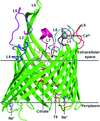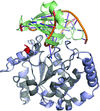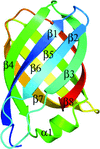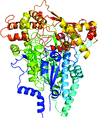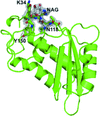issue contents
August 2014 issue

Cover illustration: Two serum amyloid P component pentamers cross-linked by five CPHPC drug molecules (p. 2232). The fivefold symmetry increases drug affinity by over a thousand fold.
research papers
Download citation


Download citation


Open  access
access
 access
accessCrystal structures of the β-barrel porin AlgE reveal a mechanism whereby alginate is exported from P. aeruginosa for biofilm formation.
A new algorithm for fitting protein structures into low-resolution electron-density (e.g. cryo-electron microscopy) maps is presented. The algorithm uses three-dimensional orthogonal Hermite functions for fast operations on the electron density.
The first structural insight into the catalysis of the yeast CoQ6 biosynthesis pathway is provided.
Open  access
access
 access
accessA structural and biophysical study of the interactions between cod and human uracil-DNA N-glycosylase (UNG) and their inhibitor Ugi is presented. The stronger interaction between cod UNG and Ugi can be explained by a greater positive electrostatic surface potential.
PDB reference: UNG–Ugi complex, 4lyl
SAXS analysis suggests that in solution CAOs homodimers could undergo a conformational change. The D3 domain seems to move with respect to the rest of the protein, increasing the accessibility of the active site.
Open  access
access
 access
accessUnit-cell reproducibility is improved by maintaining the humidity of crystals during cryomounting.
Lipocalin-type prostaglandin D synthase (L-PGDS) is the first member of the important lipocalin family to be recognized as an enzyme. The X-ray structures of nine crystal forms of one single mutant, three double mutants and a triple mutant of human L-PGDS have been solved.
Open  access
access
 access
accessVapD is one of a set of highly homologous virulence-associated proteins from the multi-host pathogen Rhodococcus equi. The crystal structure reveals an eight-stranded β-barrel with a novel fold and a glycine rich `bald' surface.
PDB reference: VapD, 4csb
Open  access
access
 access
accessThe beneficial engineered single-amino-acid deletion variants EGFPD190Δ and EGFPA227Δ have been studied.
Open  access
access
 access
accessCrystal structures of mouse, rat and human catechol-O-methyltransferase were determined in apo, semi-holo, holo and Michaelis forms under a variety of conditions. Domain swaps and large conformational changes in the active sites are observed, which testify to why this enzyme is a difficult drug target.
Crystal structure and molecular dynamics simulations analysis of the type VI secretion phospholipase effector Tle1 provide insights into its hydrolysis and membrane targeting.
PDB reference: Tle1, 4o5p
Open  access
access
 access
accessThe first structure of an S. mansoni venom allergen-like protein is presented.
PDB reference: SmVAL4, 4p27
Open  access
access
 access
accessThe sulfur SAD phasing method was successfully used to determine the structure of the N-terminal domain of HCV E1 from low-resolution diffracting crystals by combining data from 32 crystals.
PDB reference: N-terminal domain of the ectodomain of HCV E1, 4uoi
Open  access
access
 access
accessA new method for the treatment of partial reflections from X-ray snapshots is implemented in the program package nXDS, which yields intensity data of almost the same quality as those obtained by the classical rotation method.
The adsorption of Rb+, Cs+, Mn2+, Co2+ and Yb3+ onto lysozyme has been investigated by mass spectrometry and X-ray crystallography in order to provide evidence for the structural basis of the Hofmeister cation series. The number and type of binding sites have been determined. The effects of cryocooling and glycerol on cation binding are also reported.
PDB references: HEWL in 0.5 M MnCl2, data collected at room temperature, 4neb; HEWL in 1.1 M MnCl2, data collected at room temperature, 4nfv; HEWL in 1.9 M CsCl, data collected at room temperature, 4ng1; dialyzed HEWL batch-crystallized in 1.9 M CsCl, data collected at 100 K, 4ng8; previously deionized HEWL crystallized in 1.0 M RbCl, data collected at 125 K, 4ngi; dialyzed HEWL batch-crystallized in 1.0 M RbCl, data collected at 100 K, 4ngj; previously deionized HEWL batch-crystallized in 0.2 M CoCl2, 4ngk; previously deionized HEWL batch-crystallized in 1.0 M CoCl2, 4ngo; previously deionized HEWL batch-crystallized in 0.6 M CoCl2, 4ngl; previously deionized HEWL batch-crystallized in 0.5 M YbCl3, 4ngv; dialyzed HEWL batch-crystallized in 0.5 M YbCl3, data collected at 100 K, 4ngw; dialyzed HEWL batch-crystallized in 0.75 M YbCl3, data collected at 100 K, 4ngy; previously deionized HEWL crystallized in 0.48 M YbCl3/30%(v/v) glycerol, data collected at 125 K, 4ngz
Download citation


Download citation


Open  access
access
 access
accessSerum amyloid P component is a pentameric plasma glycoprotein that recognizes and binds to amyloid fibres in a calcium-dependent fashion and is likely to contribute to their deposition and persistence in vivo. Five molecules of the drug CPHPC avidly cross-link pairs of protein pentamers and the decameric complex is rapidly cleared in vivo. Crystal structures of the protein in complex with a bivalent drug and cadmium ions, which improve crystal quality, allow the definition of the preferred bound drug isomers.


 journal menu
journal menu











